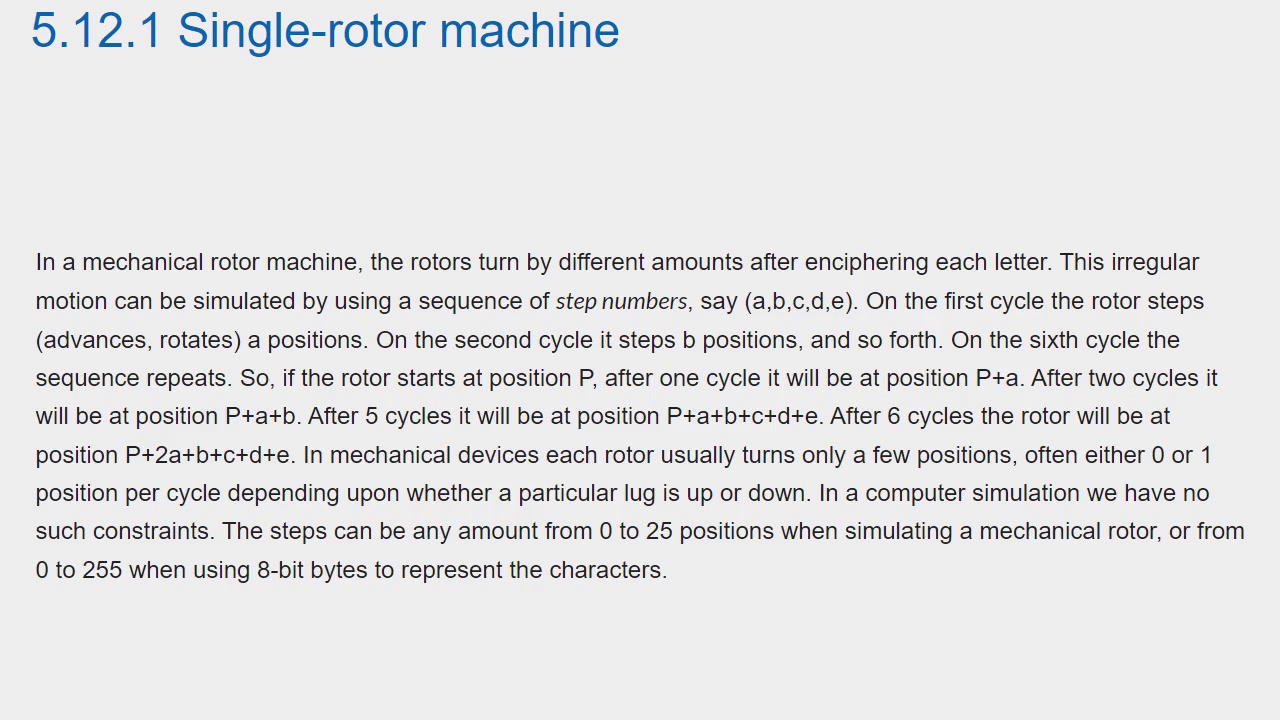001. Chapter 1. Introduction
002. Chapter 2. What is cryptography
003. Chapter 2. Types of cryptography
004. Chapter 2. Mechanical vs. digital
005. Chapter 2. Why choose Secret Key
006. Chapter 3. Preliminary concepts
007. Chapter 3. Number bases
008. Chapter 3. Prime numbers
009. Chapter 4. Cryptographers toolbox
010. Chapter 4. Transposition
011. Chapter 4. Chained digit generator
012. Chapter 5. Substitution ciphers
013. Chapter 5. Simple substitution
014. Chapter 5. Mixing the alphabet
015. Chapter 5. Nomenclators
016. Chapter 5. The Kasiski method
017. Chapter 5. Index of Coincidence
018. Chapter 5. Solving a polyalphabetic cipher
019. Chapter 5. Solving a general polyalphabetic cipher
020. Chapter 5. Running key
021. Chapter 5. Simulated rotor machines
022. Chapter 5. Three rotor machine
023. Chapter 6. Countermeasures
024. Chapter 6. Interrupted key
025. Chapter 6. Bigram and trigram substitution
026. Chapter 6. Adding null bits
027. Chapter 7. Transposition
028. Chapter 7. Columnar transposition
029. Chapter 7. Double columnar transposition
030. Chapter 7. Key transposition Part 1
031. Chapter 7. Key transposition Part 2
032. Chapter 8. Jefferson Wheel Cypher
033. Chapter 8. Ciphertext only solution
034. Chapter 9. Fractionation
035. Chapter 9. Solving a Playfair cipher
036. Chapter 9. Three Square
037. Chapter 9. Bifid
038. Chapter 9. Diagonal bifid
039. Chapter 9. Rectangular grids
040. Chapter 9. Cyclic 8-N
041. Chapter 10. Variable length fractionation
042. Chapter 10. Periodic lengths
043. Chapter 10. Post tag systems
044. Chapter 10. Different length tags
045. Chapter 10. Text compression
046. Chapter 10. Arithmetic coding
047. Chapter 10. Adaptive arithmetic coding
048. Chapter 11. Block ciphers
049. Chapter 11. Double DES
050. Chapter 11. Matrix multiplication
051. Chapter 11. Fixed vs. keyed substitution
052. Chapter 11. Involutory block cipher
053. Chapter 11. Ripple ciphers
054. Chapter 11. Block chaining
055. Chapter 11. Chaining mode summary
056. Chapter 12. Principles for secure encryption
057. Chapter 12. Confusion
058. Chapter 12. Correlation coefficient
059. Chapter 12. Base 26 linearity
060. Chapter 12. Base 256 linearity
061. Chapter 12. Adding a backdoor
062. Chapter 12. Condensed linearity
063. Chapter 12. Constructing an S box
064. Chapter 12. Diffusion
065. Chapter 12. Saturation Part 1
066. Chapter 12. Saturation Part 2
067. Chapter 13. Stream ciphers
068. Chapter 13. Multiplicative congruential generator Part 1
069. Chapter 13. Multiplicative congruential generator Part 2
070. Chapter 13. Linear congruential generator
071. Chapter 13. Chained addition generator
072. Chapter 13. Mersenne Twister
073. Chapter 13. Estimating the period
074. Chapter 13. Combining generators Part 1
075. Chapter 13. Combining generators Part 2
076. Chapter 13. True random numbers
077. Chapter 13. Refreshing the random bytes
078. Chapter 13. Hash functions
079. Chapter 14. One time pad
080. Chapter 14. Key supply
081. Chapter 14. Diffie Hellman key exchange
082. Chapter 14. Constructing large primes, new Part 1
083. Chapter 14. Constructing large primes, new Part 2
084. Chapter 15. Matrix methods
085. Chapter 15. Transposition matrix
086. Chapter 15. Hill cipher, computer versions
087. Chapter 15. Large integer multiplication
088. Chapter 15. Solving a linear congruence
089. Chapter 15. Laddering
090. Chapter 15. Large integer ciphers
091. Chapter 15. Multiplication modulo P
092. Chapter 15. Rings
093. Chapter 15. Matrices over a ring
094. Chapter 15. Finding an invertible matrix
095. Chapter 16. Three pass protocol
096. Chapter 16. Discrete logarithm
097. Chapter 16. Factoring
098. Chapter 16. Matrix three pass protocol
099. Chapter 16. Maximum order
100. Chapter 16. Solving bilinear equations
101. Chapter 16. Two sided three pass protocol
102. Chapter 17. Codes
103. Chapter 18. Quantum computers
104. Chapter 18. Error correction
105. Chapter 18. Equations
106. Chapter 18. Minimization
107. Chapter 18. Ultracomputers
108. Chapter 18. Ultrasubstitution cipher US A
109. Epilogue

